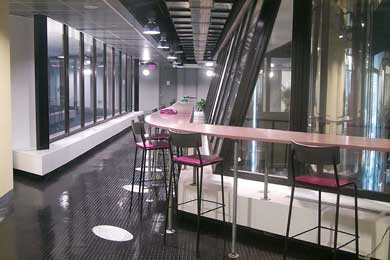|
An upstart high-tech company and a two-and-a-half-century-old university have combined in a real estate arrangement that has enabled Columbia to lease high-tech Class A space in a high-rent Wall Street district for one-half to one-third of what it would have paid without striking this partnership.
The site at 100 William Street opened recently, bringing Columbia's Continuing Education and Special Programs popular Computer Technology Applications (CTA) and the Advanced Information Technology Management (AITM) programs to the Financial District, where most of the program's students have day jobs.
With a creative arrangement, Columbia Continuing Education was able to lease 10,700 square feet from Eureka Broadband Corporation, which had been planning to build a sleek high-tech conference and workshop space it needed only from 9 a.m. until 5 p.m., Monday through Friday. Since many of CTA's students work in law firms or banking and brokerage houses, Columbia Continuing Education needed space exactly when Eureka didn't only for the evenings and weekends.
"This is a prime example of industry partnering with an established Ivy League university," said Paul M. McNeil, associate dean of Continuing Education and Special Programs. "Eureka had something we needed space in the Wall Street area to help us accommodate the growth in our programs, and a building wired with the most high-tech, state-of-the-art Broadband Internet connections presently available."
McNeil said Columbia was able to offer Eureka a commitment to provide two upfront payments of $300,000 each one this month, one in July to defray building costs, which overall totaled $1.3 million. In return, Eureka CEO Bob Vanech agreed to lease the space to Continuing Education and Special Programs for an annual fee of $198,450 for the next five years, and $221,973 for the five years after that. With the upfront building costs amortized over the next 10 years, the rent for the next five years works out to only $22 a square foot each month, and includes everything from electricity costs to computer maintenance.

|
|
|
McNeil, who struck the deal with Vanech, said that according to CoStar, the industry standard for rating commercial real estate, Continuing Education and Special Programs would have had to pay in excess of $40 a square foot, the average price for Class A Wall Street real estate as of November 30, 1999. In addition, the space would have cost him much more than the $600,000 he provided in building costs if Eureka, which provides Broadband services to tenants in specialized office buildings, had not done the wiring.
"This agreement, which lets both Eureka Broadband and Columbia Continuing Education get the most from this space, is a perfect New York partnership," said Vanech. "It's an exciting alliance between established Columbia and a start-up company in the high-tech industry, one of the city's fastest-growing sectors. It's a sign of where our city is headed."
AITM prepares experienced information technology professionals for management positions in database operations, product development or information systems. The newly-relaunched CTA program offers certification in C++ and Java: Programming and Software Development; Database Application Development and Design; Network Administration and Design; Analysis and Design of Information Systems; and Software Development for Electronic Commerce.
>
Almost all of CTA's 650 students work full time, and in recent years, McNeil said the program has grown, especially drawing more students from Silicon Alley's high-tech companies. Soon, Columbia Continuing Education plans to use the site for its ACCESS corporate training program and possibly its English as a second language courses. The new William Street site can serve between 75 and 125 students at one time.
Since creating the initial agreement last spring, Continuing Education and Special Programs has worked in close concert with Eureka Broadband to design the space so that it meets the needs of both institutions. One large room seats 75 when used as a classroom, but convertible walls allow it to open up into a much larger reception area, which can hold up to 150 people. Conference rooms with digital overhead projectors allow for corporate presentations as well as Powerpoint teaching presentations.
The space is the perfect place for Continuing Education and Special Programs downtown. That it's state-of-the-art is apparent from the first step inside. The architecture firm, NBBJ, has made an otherwise-unusable stretch of space along a wall of windows and radiators into a cyber cafe, by lining it with a curved wooden table and bordering it with high stools. Under the table will be hidden ethernet connections, so students can hop up and work on assignments or check their email between work and class.
Two classrooms each are filled with 25 flat-screened computers with Pentium III processors, and every computer is wired with premium Internet Protocol (IP) based lines that offer superfast T3 access. In a few months, Eureka Broadband also plans to link all the computers in each classroom with a single touchpad, so an instructor can display the contents of each student's computer on a large screen. The classrooms also have six-foot projector screens and state-of-the-art LCD projectors.
In addition, the lecture hall and conference rooms each have projectors, as well as six and nine-foot video screens. The conference rooms also feature state-of-the-art Cisco video-conferencing equipment.
The space is functional but it's also attractive blending spare, ultra-modern design with more traditional decor to give it a warm, comfortable feel. In one room, a sleek, distressed-metal podium stands at the front of the lecture room. Steel grey doors with round windows open into the meeting rooms, and conference tables are a rich, dark wood. Walls are lemon yellow and salmon pink.
"The facility could never have been established on the money we had to spend, but this is just an example of how Columbia is able to do more with less. At the core, this story is about a partnership between two people who trusted each other, who were trying to build a vision of education and entrepreneurship. Each had something to offer the other," said McNeil.
|
